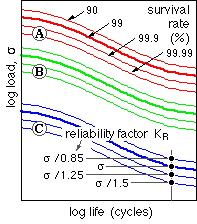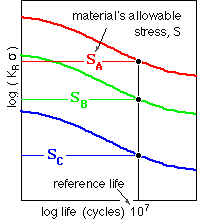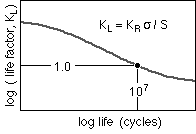How load-life information is condensed
This page offers a simplistic explanation of how the load-life-reliability characteristics of a number of similar materials are condensed into a single characteristic for the type of loading concerned.
 For a certain type of loading ( bending or contact ) the load- life- reliability characteristics are sketched for three materials A, B and C. The materials are similar (eg. all steel) so the characteristics are of similar shape and parallel - the actual shape depending upon the type of loading.
For a certain type of loading ( bending or contact ) the load- life- reliability characteristics are sketched for three materials A, B and C. The materials are similar (eg. all steel) so the characteristics are of similar shape and parallel - the actual shape depending upon the type of loading.
For each material the load corresponding to a certain life and 99% reliability ( ie. 1 in 100 failures ) is σ.
Due to the parallel nature of the characteristics in the log- log plot, the load for the same material and life but different reliability is σ/KR where the value of the reliability factor, KR depends only upon the reliability.
 The characteristics for different reliabilities are first scaled by the corresponding reliability factors - that is replotted using a KRσ ordinate - to yield a single characteristic for each material as shown on the left.
The characteristics for different reliabilities are first scaled by the corresponding reliability factors - that is replotted using a KRσ ordinate - to yield a single characteristic for each material as shown on the left.
A reference life of 10 Mc is established. For each material the load corresponding to this reference life is the material's allowable stress, S - a unique property of the material for the type of loading concerned.
 When the KRσ characteristic of each material is finally normalised by its allowable stress, then one unique characteristic results, corresponding to all the materials A, B, C and the type of loading.
When the KRσ characteristic of each material is finally normalised by its allowable stress, then one unique characteristic results, corresponding to all the materials A, B, C and the type of loading.
The normalised quantity is called the life factor, KL = KRσ /S. The life factor is unity at the reference life, 10 Mc.
AGMA 2001-B88 distinguishes between bending and contact by using the symbols 'K' for bending and 'C' for contact.
Given this unique life factor - life characteristic for a set of materials under a certain type of loading, then for a particular material of the set ( S ) and reliability ( KR ), the life for a certain load ( σ) may easily be determined, and vice versa.
 Copyright 1999-2005 Douglas Wright,
doug@mech.uwa.edu.au
Copyright 1999-2005 Douglas Wright,
doug@mech.uwa.edu.au
last updated May 2005
 The characteristics for different reliabilities are first scaled by the corresponding reliability factors - that is replotted using a KRσ ordinate - to yield a single characteristic for each material as shown on the left.
The characteristics for different reliabilities are first scaled by the corresponding reliability factors - that is replotted using a KRσ ordinate - to yield a single characteristic for each material as shown on the left.
 For a certain type of loading ( bending or contact ) the load- life- reliability characteristics are sketched for three materials A, B and C. The materials are similar (eg. all steel) so the characteristics are of similar shape and parallel - the actual shape depending upon the type of loading.
For a certain type of loading ( bending or contact ) the load- life- reliability characteristics are sketched for three materials A, B and C. The materials are similar (eg. all steel) so the characteristics are of similar shape and parallel - the actual shape depending upon the type of loading.
 When the KRσ characteristic of each material is finally normalised by its allowable stress, then one unique characteristic results, corresponding to all the materials A, B, C and the type of loading.
When the KRσ characteristic of each material is finally normalised by its allowable stress, then one unique characteristic results, corresponding to all the materials A, B, C and the type of loading.